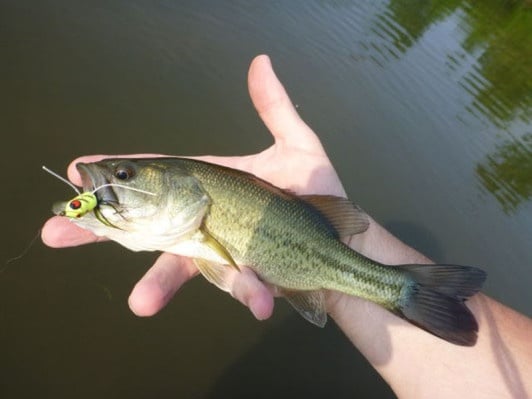Do you have a pond with too many, stunted, one-pound bass? If your bass are undersized, this can typically be a sign that there are not enough forage fish, too many bass in the pond, or a combination of both. Too often, pond owners, prescribe to the practice of catch and release, which is more in line with big lake fishing, and not conducive to growing healthy bass in small ponds.
Harvest is an important part of pond management that people need to be aware of. Harvest can create a necessary balance between forage fish and predator fish, giving your bass plenty to eat, and with less competition. Bluegill are a great forage fish for your largemouth bass, and with proper management can be the backbone of your bass food chain and a key to raising trophy bass.
Bluegill can be identified by their round, flat body, and the dark spot on the edge of the gill plate, and at the base of the dorsal spines. The side of the head and chin are a dark shade of blue, they have a yellowish breast and abdomen, and the breast of the breeding male will be a bright orange. Several species of sunfish are commonly referred to as “perch”, but bluegill are most easily identified by the size of their mouth. Even when handling a large bluegill it would be difficult to use your thumb to hold the lip. Check out this post about sunfish identification.
Most pond owners will have knowledge of what bluegill look like, but may not know what their spawning behaviors or habitat preferences are. Male bluegill will build spawning nests in shallow water typically in a gravel substrate, and will ferociously defend their territory from other males, invaders, and even nearby swimmers. Females will choose a desirable male, usually larger in size to mate with. The number of eggs produced is closely related to the size of the female. A small female may produce 1,000 eggs, while a large healthy female can produce up to 100,000 eggs, although typically females can lay 10,000 to 50,000. They can also spawn three times per season. If you want to have strong populations of bluegill, you can see why having large adults are so desirable. Bluegill begins spawning in May and continues through August, with a peak during June when the waters are between 67 – 80 degrees.
It would seem that bluegill should have no problem maintaining strong populations when they spawn multiple times a season with as many eggs as they lay, but what happens when your pond does not have appropriate nesting habitat? Unfortunately, most of the reproduction is lost due to poor spawning habitat. Most earthen ponds have 2-12 inches of silt that smothers the eggs soon after they are laid. A popular solution is to add pea gravel to provide a hard bottom for nest building. This process is expensive and over time the gravel can be silted over or eroded out of the spawning zone. Pond King has developed a solution with our Honey Hole Spawning Disc, which is a 20” concave poly disc that is elevated off the bottom of the pond on a 9” PVC stake. They also come available with a metal bracket attached to the bottom that allows pond owners to toss them in the pond without treading in the water themselves. The Honey Hole Spawning Disc will not rot. It provides a stable, solid surface for bluegill, redear, bass, and crappie to deposit their eggs. Also, other forage fish including fatheads and threadfin shad will use the underside of the disc to attach their eggs. When the fry hatch, they will have a ready supply of algae that will grow around the edges and beneath the disc. Just one successful spawn will produce more than enough added value in fish to make your investment worthwhile.
If you want to cure your stunted bass, ensure you have proper numbers of forage fish, especially bluegill. With the right knowledge, you can have a large brood stock and stable reproduction with proper habitat.
Happy Fishing!
Brad Metzler, President



